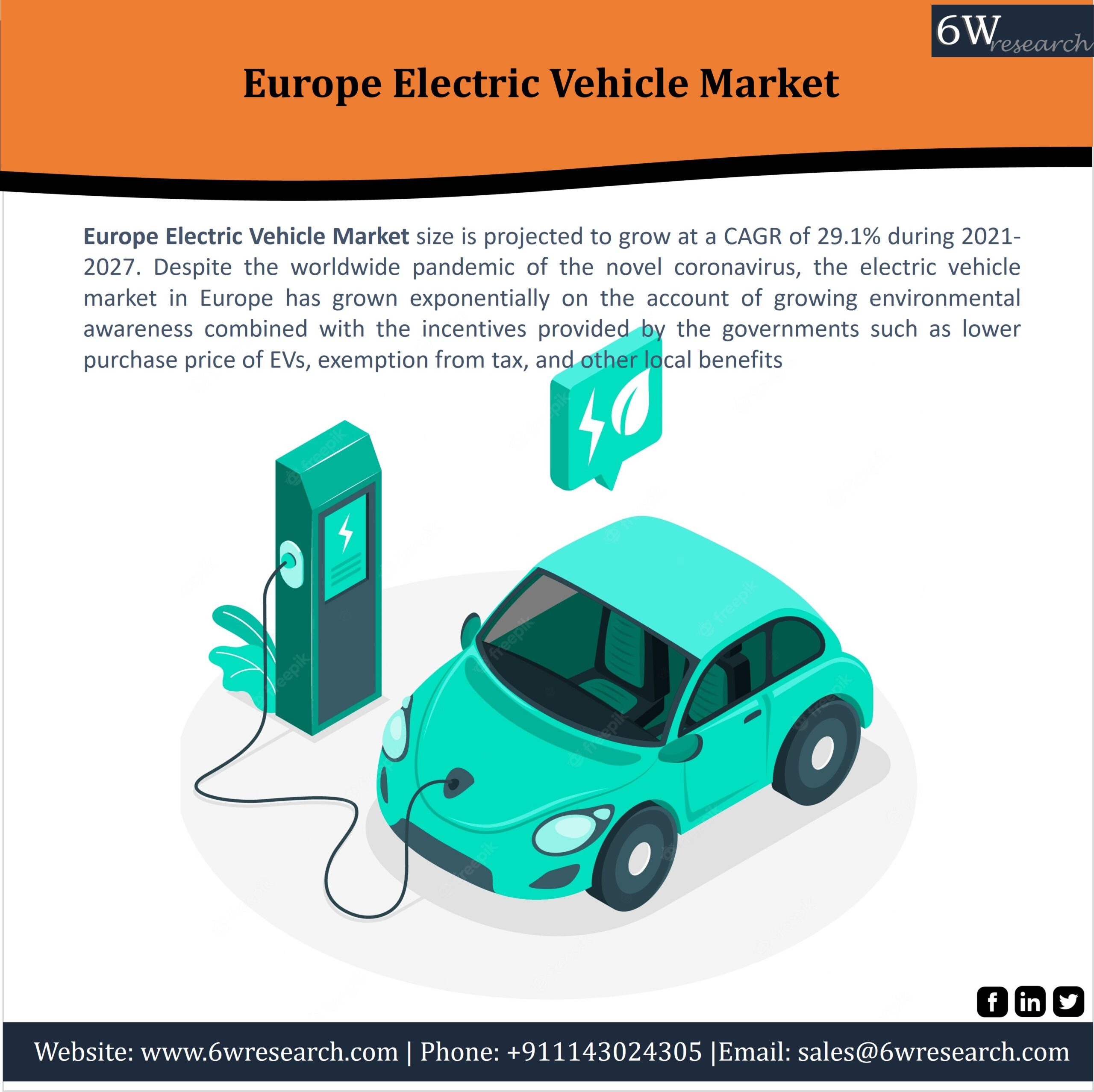
Introduction of Europe Electric Vehicle Market
Electric vehicles are gaining popularity in Europe as consumers become more aware of the benefits of these vehicles. The Europe electric vehicle market is expected to grow at a compound annual growth rate of XX% from 2019 to 2030, reaching a market size of over €XX billion.
This growth is being driven by a few factors, including increasing environmental concerns, government incentives, and falling battery prices. As electric vehicles become more affordable and convenient, it is expected that their adoption will continue to increase in Europe.
There are several different types of electric vehicles available on the market, including passenger cars, buses, trucks, and motorcycles. In 2019, passenger cars accounted for the largest share of the Europe electric vehicle market, with a share of over XX%.
The Europe electric vehicle market is led by countries such as Germany, Norway, and the United Kingdom. These countries have developed strong infrastructure and policies to support the adoption of electric vehicles. For example, Germany offers generous subsidies for buyers of electric vehicles, while Norway has exempted these vehicles from many taxes.
As the Europe electric vehicle market continues to grow, it is expected that new entrants will enter the market and that competition will increase. This will provide consumers with greater choice and lead to further innovation in this rapidly-growing sector.
Segmentation of the Europe Electric Vehicle Market
To better understand the electric vehicle market in Europe, it is important to first segment the market. Segmentation allows for a more targeting of strategies, products, and services to specific groups within the market that have common needs and/or wants. There are several ways to segment a market, but for the purposes of this blog article, we will focus on three key dimensions: geography, vehicle type, and ownership type.
Geography: When segmenting the Europe electric vehicle market by geography, we can look at both national and urban markets. At the national level, some countries are further ahead than others in terms of EV adoption. For example, Norway has been a leader in EV adoption due to its aggressive policies and incentives aimed at getting more EVs on the road. As a result, nearly XX% of all new car sales in Norway are EVs. In contrast, other countries like Germany have been slower to adopt EVs, with less than XX% of new car sales being EVs. At the urban level, we can see similar patterns emerge. Cities like London and Paris have been early adopters of EVs due to strong policies encouraging their use, while other cities lag.
Vehicle Type: Another way to segment the Europe electric vehicle market is by vehicle type. The two main types of EVs are passenger cars and commercial vehicles (e.g., vans and trucks). Passenger cars make up many EV sales in Europe (XX%), but there is still.
Europe Electric Vehicle Market Drivers and Opportunities
The Europe electric vehicle market is driven by a few factors, including government incentives, consumer preferences, and advancements in technology.
Government incentives are a major driver of the Europe electric vehicle market. A number of countries in Europe offer financial incentives to consumers who purchase electric vehicles, as well as tax breaks and other benefits. These incentives make electric vehicles more affordable and appealing to consumers.
Consumer preferences are also a significant driver of the Europe electric vehicle market. An increasing number of consumers are interested in purchasing environmentally-friendly cars, and many see electric vehicles as a way to reduce their carbon footprint. In addition, electric vehicles have a few other advantages over traditional gas-powered cars, including lower running costs and maintenance costs.
Finally, advancements in technology are making electric vehicles more reliable and efficient, which is helping to boost sales. Electric vehicle battery technology has progressed significantly in recent years, making batteries smaller and lighter while also increasing range and reducing charging time. In addition, new fast-changing technologies are being developed that will further improve the convenience of owning an electric vehicle.
Challenges and Risk Factors of the Europe Electric Vehicle Market
Electric vehicles (EVs) have been gaining popularity in Europe as a whole, but there are still some challenges that need to be addressed before they can become mainstream. One of the main challenges is the high up-front cost of EVs, which can deter potential buyers. Another challenge is the lack of infrastructure to support EVs, such as charging stations. Additionally, range anxiety – the fear of running out of charge while on the road – is still appearing for many consumers.
There are also some risks associated with EVs that need to be considered. One risk is that battery technology may not be able to meet the demands of electric vehicles, leading to range and performance issues. Another risk is that oil prices could rebound, making EVs less attractive from a financial perspective.
Despite these challenges and risks, there is still significant potential for growth in the Europe EV market. With continued improvements in technology and more investment in infrastructure, EVs are expected to become increasingly popular in the coming years.
Europe Electric Vehicle Market Demand Analysis by Country/Region
The electric vehicle market in Europe is forecast to grow at a CAGR of over XX% during the period 2020-2025.
The Europe electric vehicle market is expected to register robust growth owing to the stringent emission norms and regulations, growing concerns over air pollution, and increasing preferences for sustainable mobility options. The EU has set a target of XX% of all new cars sold being electrically chargeable by 2030, which is expected to drive the market growth.
Germany, France, and the UK are the major electric vehicle markets in Europe. The German electric vehicle market is anticipated to grow significantly on account of the government incentives and policies aimed at promoting e-mobility. The ongoing efforts to expand the charging infrastructure are further expected to fuel the market demand. The French government’s plan to invest over EUR XX billion by 2022 towards developing the required charging infrastructure is likely to create significant opportunities for market players operating in the country.
In terms of battery type, lithium-ion batteries are expected to dominate the Europe electric vehicle market owing to their higher energy density as compared to other battery types. In terms of vehicle type, passenger cars are projected to be the largest segment of the Europe electric vehicle market on account of the growing preference for eco-friendly passenger cars among consumers.
Key Players of the Europe Electric Vehicle Market
There are a few key players in the Europe electric vehicle market that are worth mentioning. These companies are leading the way in terms of innovation and production when it comes to electric vehicles.
First, there is Tesla. This company is based in the United States but has a strong presence in Europe as well. Tesla is known for its luxury electric vehicles that are some of the most technologically advanced on the market. The company has been expanding its reach in Europe and plans to open more stores and service centres in the future.
Second, there is BMW. This German automaker has been a leader in luxury vehicles for many years, and it has also been at the forefront of electric vehicle development. BMW offers a range of different electric models, including the i3 city car and the i8 sports car. The company has also announced plans to launch an all-electric version of its popular 3 Series sedan in 2019.
Third, there is Volkswagen. Volkswagen is one of the world’s largest automakers and it is also a major player in the Europe electric vehicle market. The company offers several different all-electric models, including the e-Golf and e-Up. Volkswagen has committed to investing billions of Euros into electric vehicle research and development over the next few years as part of its “Roadmap E” plan.
Finally, there is Renault-Nissan alliance. This alliance between two major automakers has resulted in some very impressive electric vehicles being produced, such as the Nissan.
Europe Electric Vehicle Market Strategies for Growth
There are several strategies that can be adopted to drive growth in the Europe electric vehicle market. Firstly, policy support from governments and other institutions is critical to create a favourable environment for the uptake of electric vehicles. Incentives such as tax breaks, subsidies and investment in infrastructure can all help to make electric vehicles more attractive to consumers. Secondly, education and awareness-raising campaigns targeting both the public and key decision-makers such as fleet managers and business owners can help to increase the visibility of electric vehicles and build confidence in their capabilities. Finally, partnerships between car manufacturers, utility companies and other stakeholders can help to create a more integrated and seamless experience for consumers looking to switch to electric vehicles.
Conclusion of the Europe Electric Vehicle Market
In conclusion, the Europe electric vehicle market is set to grow considerably due to several factors such as increasing environmental concerns, government initiatives and subsidies, technology advancements and falling battery prices. Automotive OEMs have already shifted their focus towards EV production which should further enhance its demand in the coming years. EVs are slowly becoming more accessible to a wider customer base through improved charging infrastructure, better range performance and access to specialised finance options for purchase or leasing. With these developments, we expect that by 2027 Europe will hold an important position within the global automotive industry with its large share of EV usage.









